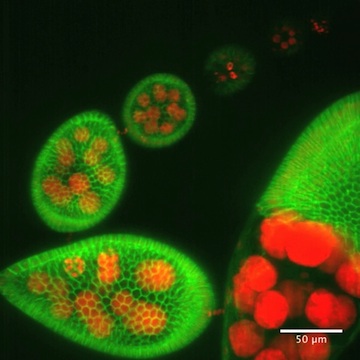When one hears the phrase 'egg-shaped', an oval immediately comes to mind. Chicken eggs are oval, and so are the eggs laid by many land-dwelling animals. But how do oval eggs get that way? Starting from this deceptively simple question, MCB Associate Professor David Bilder and graduate student Saori Haigo report in the journal Science the discovery of a new type of tissue movement that shapes animal organs.
Eggs of the fruit fly Drosophila, like eggs of chickens, are oval but begin their development nearly perfectly round. Haigo and Bilder set out to understand how this simple shape change occurs by making the first live movies of elongating fly eggs. They found that during a certain period, the entire developing egg spins several times around what will later becomes its long axis. This discovery was surprising because decades of work studying fixed Drosophila ovaries overlooked it; the 'treadmill-like' nature of the movement means that it could only be detected via imaging living tissue. Mutant fly eggs that cannot undergo rotation do not elongate; they emerge from the body distinctively round. The researchers showed that the tissue revolutions organize a surrounding extracellular matrix into a circumferential 'corset' that channels egg growth specifically along a single axis, thus sculpting the egg. While this is the first description of a whole-tissue rotation in any animal, the authors speculate that other examples where this type of movement shapes epithelial organs will be uncovered as live imaging is applied to developing vertebrate tissues such as lung and kidney.
